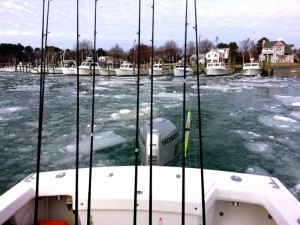chesapeake bay
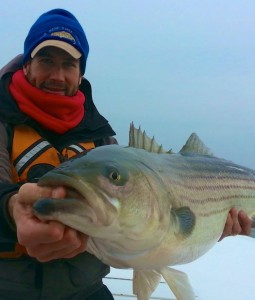 Being a good fisherman has always been about being smart enough, and humble enough to learn when given a chance. -Anthony Bourdain
Being a good fisherman has always been about being smart enough, and humble enough to learn when given a chance. -Anthony Bourdain
Actually, Bourdain never said that. Well, he did, but it was about cooking, not fishing. Some of the best fishermen I know like to cook. I guess that’s because there are a lot of similarities. I’ve recently had the opportunity to spend time with some very talented up-and-coming striper fishermen. What impresses me most is their willingness to open their minds and learn. As a result, they’re enjoying some of the best fishing experiences of their lives. That willingness to learn is a trait I’m including in a book I’m working on called, The Right Stuff.
According to the website Cookingschools.com, there are ten top qualities of a great culinary professional. As I read through them, I found it interesting how each of those qualities apply just as easily to great fishing. I hope they won’t mind if I parody their list a little by substituting fishing terms. Take a look to see if you have the recipe for a quality fishing experience. The few words I substituted are in italics.
Creativity: A great angler must be very creative and always willing to try something new. Creativity inspires a lure’s presentation, which is very important to the overall fishing experience.
Passion: A great angler has a tremendous passion for fish and fishing. They enjoy the process of selecting gear, preparing for trips, and creating lures. Read More!
That was the text message I got from my fishing partner Rich early on Super Bowl Sunday morning. It was a beautiful winter day with high temperatures expected to be in the 40s. Winds were light, skies were clear, and a new moon was pushing swift tides up the Chesapeake Bay. There was no reason to postpone our usual Sunday afternoon fishing trip, right? Well, no reason except for the 75 miles of ice clogging our waters.
It’s been a cold winter so far on the Chesapeake Bay. The Bay has frozen all the way across at the Bay Bridge on a couple of mornings and the Eastern shore has been iced in all the way up from Taylors Island to the Susquehanna Flats. The weekend warm-up had loosened up some areas, but almost all the Eastern Shore ramps were still packed in solid.
“Let’s try,” I shot back. We were suffering from serious cases of cabin fever and really wanted to go fishing. My next message went to the third member of our Sunday fishing trio, Jamie. “Any chance you can find an open ramp?” I typed. Both Jamie and Rich grew up on the Shore, and they have plenty of friends and relatives around the water. I imagined the local cellular networks were overwhelmed for a while as they called everyone they knew looking for a place to launch. A whistle from my phone alerted me to a possible plan. Jamie was forwarding pictures of an ice-free Knapps Narrows from his buddy Brian who lives on Tilghman Island. Jamie’s follow up text read, “My dad says Tilghman is always open. Those boys gotta fish.”
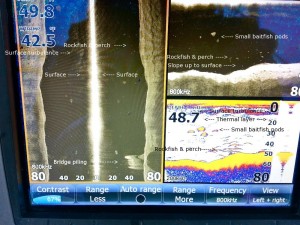 We interrupt this conservation blog with a fishing report. Nah, it’s the other way around. Chesapeake Light Tackle will always be first and foremost a fishing-report website. Well, fishing reports along with some occasional good advice about gear and techniques. Don’t worry – I won’t be lightening up on Maryland DNR’s bad decision to increase rockfish harvest by 14 percent in the face of impending cuts, but I wanted to let you know that I have been lighting up some local fishing spots lately. It’s the holidays, and the weather hasn’t been great, but there are still some fish to be caught for those who are willing to brave the elements and cast for them. The warm water discharges have been hit-and-miss lately. Most of the anglers who have visited them have been disappointed, but once in a while, I hear of a good fish or two being caught. The same goes for the deep holes at the mouths of the rivers and also for my go-to-winter honey hole: Light Tackle University (“LTU”). Read More!
We interrupt this conservation blog with a fishing report. Nah, it’s the other way around. Chesapeake Light Tackle will always be first and foremost a fishing-report website. Well, fishing reports along with some occasional good advice about gear and techniques. Don’t worry – I won’t be lightening up on Maryland DNR’s bad decision to increase rockfish harvest by 14 percent in the face of impending cuts, but I wanted to let you know that I have been lighting up some local fishing spots lately. It’s the holidays, and the weather hasn’t been great, but there are still some fish to be caught for those who are willing to brave the elements and cast for them. The warm water discharges have been hit-and-miss lately. Most of the anglers who have visited them have been disappointed, but once in a while, I hear of a good fish or two being caught. The same goes for the deep holes at the mouths of the rivers and also for my go-to-winter honey hole: Light Tackle University (“LTU”). Read More!
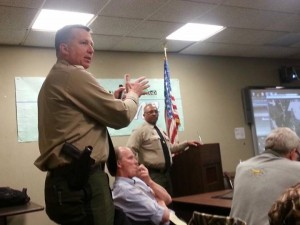 Would you believe in an advanced Doplar-based marine radar system that can detect a 3-foot-square object from 7 miles away? Well, you better because it might just be zoomed in on you next time you’re fishing on the Chesapeake Bay. Last night, I attended a presentation by the Maryland Natural Resources Police (NRP) about a new law enforcement tool called MLEIN. That stands for the Marine Law Enforcement Information Network. It’s a mobile command center consisting of radar monitoring, video surveillance, and advanced software that allows the NRP to keep a very close watch on what’s happening on the water. I was invited to the presentation by Candy Thomson. Yes, the former Baltimore Sun Outdoors Girl has skipped across College creek to a new position in Annapolis as the Public Information Officer for the NRP. I first heard about MLEIN a couple of years ago in one of her articles in the Sun Paper. You can read it here. http://articles.baltimoresun.com/2010-12-14/sports/bs-sp-chesapeake-security-system-20101214_1_radar-units-mlein-cameras
Would you believe in an advanced Doplar-based marine radar system that can detect a 3-foot-square object from 7 miles away? Well, you better because it might just be zoomed in on you next time you’re fishing on the Chesapeake Bay. Last night, I attended a presentation by the Maryland Natural Resources Police (NRP) about a new law enforcement tool called MLEIN. That stands for the Marine Law Enforcement Information Network. It’s a mobile command center consisting of radar monitoring, video surveillance, and advanced software that allows the NRP to keep a very close watch on what’s happening on the water. I was invited to the presentation by Candy Thomson. Yes, the former Baltimore Sun Outdoors Girl has skipped across College creek to a new position in Annapolis as the Public Information Officer for the NRP. I first heard about MLEIN a couple of years ago in one of her articles in the Sun Paper. You can read it here. http://articles.baltimoresun.com/2010-12-14/sports/bs-sp-chesapeake-security-system-20101214_1_radar-units-mlein-cameras
That article reveals a little more than DNR Special Projects Manager Tim Bowman gave away in his presentation last night. Nevertheless, his updates for 2014 were extremely informative. The twenty-something people in attendance – including 8 guys from CCA Maryland – were glued to their seats as Bowman showed real-life examples of how the system worked. Read More!
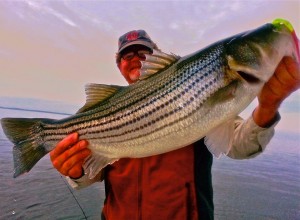 One of the more frequently asked questions I get whether by email or in person is, “How can I consistently catch bigger fish?” I’ve written about moving your game up to the next level before, but since we now have some migratory stripers in the Maryland part of the Chesapeake Bay, it’s worthwhile to address it again. The learning curve gets a little shorter in the fall and it’s a great chance to sharpen your skills. I’ll start by saying there are no hard and fast rules for catching stripers. Over my years of casting for them I feel like I’ve honed my techniques so that, on any given day, I have an edge for catching a trophy. That said, I’m still frequently surprised when a huge striper is caught by some completely different method than I’ve seen before. One thing is for sure, things change. There’s no substitute for experience but anglers who aren’t willing to stay on top of the latest innovations and newest techniques are certain to be left behind. Read More!
One of the more frequently asked questions I get whether by email or in person is, “How can I consistently catch bigger fish?” I’ve written about moving your game up to the next level before, but since we now have some migratory stripers in the Maryland part of the Chesapeake Bay, it’s worthwhile to address it again. The learning curve gets a little shorter in the fall and it’s a great chance to sharpen your skills. I’ll start by saying there are no hard and fast rules for catching stripers. Over my years of casting for them I feel like I’ve honed my techniques so that, on any given day, I have an edge for catching a trophy. That said, I’m still frequently surprised when a huge striper is caught by some completely different method than I’ve seen before. One thing is for sure, things change. There’s no substitute for experience but anglers who aren’t willing to stay on top of the latest innovations and newest techniques are certain to be left behind. Read More!
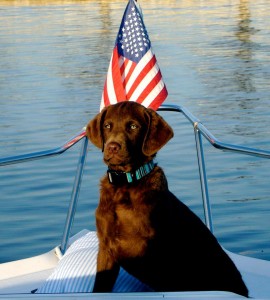 My goal in life is to be the kind of person my dog thinks I am. – The Bellamy Brothers
My goal in life is to be the kind of person my dog thinks I am. – The Bellamy Brothers
It’s easy to love a dog. On our worst days our dog still thinks we’re great. It doesn’t matter how badly we screw up, or how many catastrophes we’ve caused, in our dog’s eyes, we’re amazing. Most of the fishermen I know love dogs. Some of us take them fishing with us. Most dogs don’t care if we catch a fish or not, they’re just glad to be out on the water with us.
Crockett Lee wasn’t that kind of dog. Oh, he loved me unconditionally, but if I took him fishing and he didn’t see fish coming over the rail, he’d get mad. Real mad. I never wanted to take a skunk when Crockett was on the boat. If we got back to the dock without at least a white perch to show for our efforts, I could surely expect a severe bark-lashing. He made sure I knew I’d let him down. I think he finally got tired of my failures and took it upon himself to make me a better fisherman.
It started like this, when I moved from the Mountains to the Chesapeake Bay, my first fishing boat was a 25-foot long Sea Ray express cruiser. That boat wasn’t really designed for fishing, but I made a few angler-friendly modifications before naming her after my new Chesapeake Bay Retriever puppy and striking out to learn how to fish the Bay. Crockett grew up on Crockett’s Reel and always felt right at home there. When I got my center console a few years ago, Crockett would have none of it. He did not like Thunder Road. Gone were the comfortable carpeted floors that provided traction in rough water, and gone was the cushy upholstered seat that allowed him to sit up high and see over the rails. Read More!



